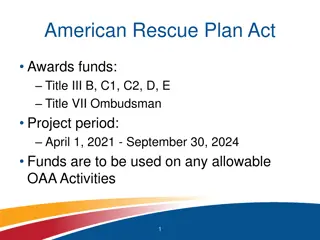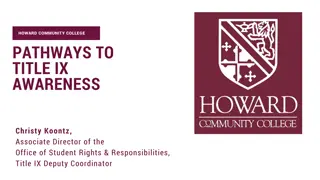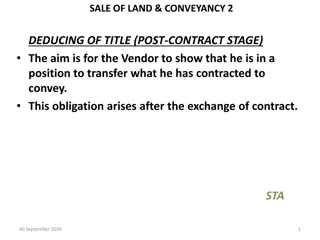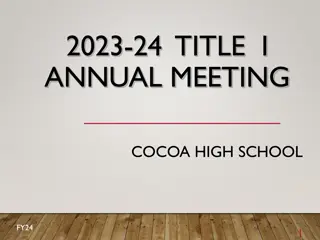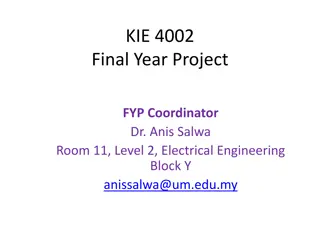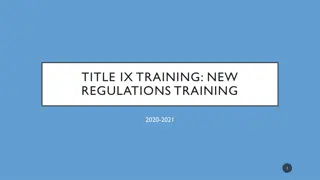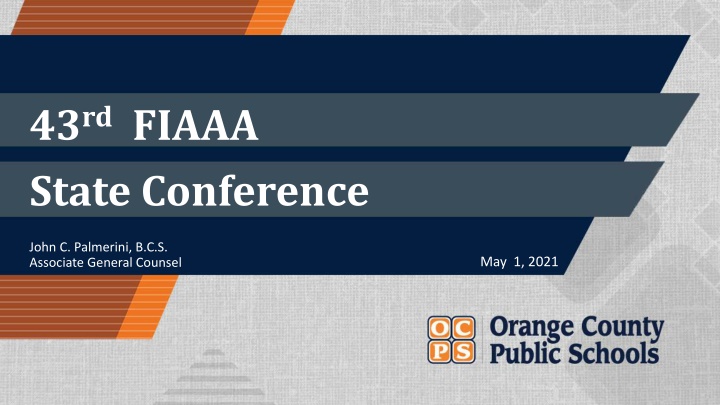
Understanding Title IX Regulations and Policies in Education
Explore the history and impact of Title IX in education, focusing on the regulations and policies implemented since its adoption in 1972. Learn about the requirements for providing equal athletic opportunity, the 1975 regulations, and the 1979 policy interpretation for compliance. Discover the key factors considered to promote gender equality in educational programs and activities receiving federal financial assistance.
Download Presentation

Please find below an Image/Link to download the presentation.
The content on the website is provided AS IS for your information and personal use only. It may not be sold, licensed, or shared on other websites without obtaining consent from the author. If you encounter any issues during the download, it is possible that the publisher has removed the file from their server.
You are allowed to download the files provided on this website for personal or commercial use, subject to the condition that they are used lawfully. All files are the property of their respective owners.
The content on the website is provided AS IS for your information and personal use only. It may not be sold, licensed, or shared on other websites without obtaining consent from the author.
E N D
Presentation Transcript
43rdFIAAA State Conference John C. Palmerini, B.C.S. Associate General Counsel May 1, 2021
Title IX Providing equality in interscholastic sports since 1972, sort of
Title IX Title IX was adopted in 1972. The text of the statute is as follows: No person in the United States shall, on the basis of sex, be excluded from participation in, be denied the benefits of, or be subjected to discrimination under any education program or activity receiving Federal financial assistance. (20 U.S.C. s. 1681(a)) 20 U.S.C. 1681(b) states that 20 U.S.C. s. 1681(a) shall not be construed to require educational institution to grant preferential or disparate treatment to the members of one sex on account of an imbalance in which may exist with respect to the total number or percentage of persons of that sex participating in any program
Title IX 1975 Regulations The former Department of Health, Education and Welfare issued implementing regulations in 1975. The regulations prohibited sex-based discrimination in any interscholastic, intercollegiate, club or intramural sport. The regulations required schools to provide equal athletic opportunity for members of both sexes.
Title IX 1975 Regulations The regulation created 10 factors to consider for providing equal athletic opportunity.: (1) Whether the selection of sports and levels of competition effectively accommodate the interests and abilities of members of both sexes; (2) The provision of equipment and supplies; (3) Scheduling of games and practice time; (4) Travel and per diem allowance;
Title IX 1975 Regulations (5) Opportunity to receive coaching and academic tutoring; (6) Assignment and compensation of coaches and tutors; (7) Provision of locker rooms, practice and competitive facilities; (8) Provision of medical and training facilities and services; (9) Provision of housing and dining facilities and services; (10) Publicity.
Title IX 1979 Policy Interpretation Almost 100 colleges and high school activities associations complained about not knowing how to comply. Department of Health, Education and Welfare, created a policy guidance for education institutions. The policy guidance was a three-part test: Whether the level of participational opportunities for male and female students are provided in numbers substantially proportionate to their respective enrollments. As such, the
Title IX 1979 Policy Interpretation When the members of one sex have been underrepresented among athletes, whether the institution can show a history and continuing practice of program expansion which is demonstrably responsive to the developing interest and abilities of members of that sex. Where members of one sex are underrepresented among intercollegiate athletes, and the institution cannot show a continuing practice of program expansion such as cited above, whether it can be demonstrated that the interest and abilities of the members of that sex have been fully and effectively accommodated by the present program. 44 Fed.Reg. 71,413 (December 11, 1979)
Title IX 1996 Clarification DOE issued a Dear Colleague letter on January 16, 1996, providing additional clarification, but not revising, the three-part test. The clarification was that educational institutions only have to comply with one part of the three-part test. The clarification also emphasized that institutions are not required to cap or eliminate participation opportunities for men.
Title IX 1996 Clarification For factor two of the three-part test, a history of program expansion is: Adding girls teams, or upgrading teams to varsity status. A history of increasing the number of students who participate in athletics from the underrepresented sex. An affirmative response to request by students for the addition or elevation of sports. The implementation of a nondiscriminatory policy or procedure for the addition of sports.
Title IX 1996 Clarification For factor three of the three-part test, the factors that the Office for Civil Rights will look at are: Is there enough interest to support a varsity-level team but there is no varsity-level team? Is there sufficient athletic ability to sustain a varsity-level team (opinions of coaches and level of success of players who participate in the sport)? Is there a reasonable expectation of competition for the team (do the teams your school normally competes against have varsity-level teams playing the sport)?
Title IX 2010 Clarification On April 20, 2010, OCR issued another Dear Colleague letter addressing part three of the three-part test. If a school eliminates a viable varsity team for underrepresented sex, then OCR will find there was sufficient interest, ability and competition to sustain a varsity level team.
Title IX 2010 Clarification OCR will look at numerous factors in determining whether there is interest by the underrepresented sex, including: Requests by students that a particular sport be added. Requests to elevate a club sport to varsity status. Participation in a club sport. Interviews with students, coaches and administrators. Results of surveys.
Title IX 2010 Clarification Schools have a continuing obligation to comply with Title IX. OCR recommends that institutions have: ongoing information on the interests and abilities of students; policies and procedure for responding to requests for new teams; and wide dissemination of such policies. procedures for collecting, maintaining and analyzing
Cases Under Title IX Sports Elimination
Cases Under Title IX Sports Elimination Equity in Athletics v. Department of Education, 504 F.Supp.2d 88 (W.D. Va. 2007): James Madison University eliminated seven men s sports and three women s sports. The ratio of sport participation before the cuts were 50.7-49.3 % female, even though the overall population was 61-39 % female. The court, in analyzing the case, said an educational unit may bring itself into Title IX compliance by increasing athletic opportunities for the underrepresented gender or by decreasing athletic opportunities for the overrepresented gender. Id. at page 101.
Cases Under Title IX Sports Elimination As for reducing more men sports, the Court held that Congress has the right to remedy past discrimination against women. The Court ultimately held It is undisputed that JMU chose to eliminate certain men s athletic programs in an attempt to comply with the requirements of Title IX. Based on the Seventh Circuit s reasoning in Kelly and the Eighth Circuit s reasoning in Miami, the court is unable to conclude that Equity s equal protection challenge to JMU s decision has a strong likelihood of success.
Cases Under Title IX Sports Elimination Cohen v. Brown University, 991 F.2d 888 (1stCir. 1993): Brown University dropped gymnastics) and two men s sports (golf and water polo). Brown estimated it would save $37k by eliminating volleyball, $24k eliminating gymnastics, $9k for water polo and $6k for golf. The ratio of sports participation was 63-37% male. The student body population was 52-48% male. The trial court ruled that the School had to keep the two women s teams while still eliminating the two men s teams. The Appeals Court agreed. two sports (volleyball and women s
Cases Under Title IX Sports Elimination Cohen v. Brown University, 101 F.3d 155 (1stCir. 1996): The Court had a second full-blown trial on the merits. In 1993-1994, Brown had athletic program 62-38% male when its student body was 52-48 % female. The Court ruled they could not meet any prong of the three-part test. The trial court had ruled that Brown had to raise women s gymnastics, water polo, skiing, and fencing to varsity status. The Appeals Court overruled the trial court by allowing Brown to eliminate men s sports.
Cases under Title IX Sports Elimination Biediger v. Quinnipiac University, 691 F.3d 85 (2d Cir. 2012): QU was sued for not offering equal participation to female students. QU had 62 percent women student population, but women only made up 58 percent of the athletes QU argued that the Courts erred by not counting 30 competitive cheerleaders in the count of varsity athletes. They also argued that the Court erred in not counting women who ran both indoor track and cross-country.
Cases under Title IX Sports Elimination With respect to the track/cross-country athletes, the Court said while it would normally count students by sport regardless of whether the students played other sports or not, the Court said QU violated Title IX by forcing the cross country team, as a condition of being on the team, to run indoor track. The court noted that the male cross country runners, unlike the female cross country runners, were not mandated to run track.
Cases under Title IX Sports Elimination With respect to cheerleaders, the Court cited a guidance document from the U.S. DOE Office of Civil Rights in 2008 stating that competitive cheerleaders was not recognized as a sport or emerging sport by the NCAA and therefore, could not count in the count of athletes on campus. The Court ruled that it was significant that QU, when its competitive cheerleaders participated in competition, was scored using five different scoring systems. Also, the Court ruled it was significant that it did not play other schools varsity cheerleading squad, and in some cases competed against cheerleaders unaffiliated with any school.
Cases under Title IX Sports Elimination Contrast the QU case with Florida FHSAA recognizes Competitive Cheerleading as a sport. FHSAA publishes a Sports Manual for Competitive Cheerleading FHSAA has a State Series championship for Competitive Cheerleading.
Cases Under Title IX Offering Elimination
Cases Under Title IX Offering Sports Horner v. Kentucky High School Athletic Association, 43 F.3d 265 (6thCir. 1994): Girls slow-pitch softball players sued KHSAA for failing to recognize girls fast-pitch softball KHSAA argued that fast-pitch softball should not be recognized because 25 percent of their schools did not indicate a willingness to participate in fast-pitch softball. The trial court dismissed the lawsuit in its entirety.
Cases Under Title IX Offering Sports The Appeals Court reversed. First, they held that since slow-pitch softball was not popular in college in comparison with fast-pitch, it placed female players at a disadvantage for competing for college scholarships. KHSAA argued that girls could try out for baseball. The Court ruled that fact was not enough to grant a judgment for KHSAA. The mere opportunity to try out for a team is not determinative of the question of previously limited athletic opportunities under Title IX. Athletic opportunities means real opportunities, not illusory ones. The Appeals Court remanded for a trial on the merits.
Cases Under Title IX Offering Sports McCormick v. School District of Mamaronek, 370 F.3d 275 (2d Cir. 2004): School district offered girls soccer in the spring, even though the State Championships were in the fall. The court ruled that having girls soccer in the spring so players could not compete for the state championship violated Title IX: high school athletic association violated Title IX by scheduling athletic seasons and tournaments for girls sports advantageous times in the academic year than boys athletic seasons. during nontraditional and less
Cases Under Title IX Offering Sports In the present case, scheduling girls soccer in the spring clearly creates a disparity, boys can strive to compete in the Regional and State Championships in soccer and girls cannot. Without a doubt, this difference has a negative impact on girls. Moreover, girls soccer is the only sport at these schools scheduled in a season that precludes championship game play. Male athletes do not suffer from any comparable disadvantage.
Cases Under Title IX Facilities Daniels v. School Board of Brevard County, 985 F.Supp. 1458(M.D. Fla. 1997): Girls softball program complained of disparities in facilities between them and baseball program. Electronic scoreboard: Baseball had one and softball did not. Batting cage: Baseball had one and softball did not. Bleachers: Girls softball had spectators than baseball. Signs: Baseball team had Merritt Island Baseball on a large structure by the baseball field. Softball had no similar sign. worse bleachers and fewer
Cases Under Title IX Facilities Bathroom facilities: Baseball had bathrooms and softball did not. Lighting: Baseball had lights and softball did not. The Court entered an injunction requiring upgrades to the softball facilities: Since these inequities should have long ago been rectified, the Court is unsympathetic to Defendant s claims that it will be unduly harmed by expenditure of funds necessary to level the playing field for girls softball athletes. For far to long, the softball team has been denied athletic opportunity equal to the baseball team. The harm associated with that treatment as second class citizens is significant.
Cases Under Title IX Facilities Daniels v. School Board of Brevard County, 995 F.Supp. 1394 (M.D. Fla. 1997): Brevard County was ordered to provide a remediation plan. Its remediation plan was as follows Electronic Scoreboard: turn off the baseball scoreboard. Batting cage: They would locate the pitching machines in the cages so the teams could use the cages in alternate weeks. Bleachers: The school would rope off the bleachers at the baseball field so only spaces equivalent to the girls softball bleachers would be available. Signs: The school would change Meritt Island Baseball to Merit Island Baseball and Softball
Cases Under Title IX Facilities Bathrooms: The school would remove a fence to allow access from the softball field to the bathroom Lighting: Install lights on girls field and discontinue usage of lights on baseball field until lights are installed on the softball field. The Court rejected the plan: Unfortunately, the Board s plan leaves much to be desired; it creates the impression that the Board is not as sensitive as it should be regarding the necessity of compliance with Title IX. The Court is inclined to agree with Plaintiffs that many of the Board s proposals seem more retaliatory than constructive. The Court ordered the removal of the fence for the restroom, establish a schedule for both teams to use the batting cage, change the sign to read Merritt Island Baseball and Softball and to speed up installation of lights.
Cases Under Title IX Facilities Landlow v. School Board of Brevard County, 132 F.Supp. 2d 958 (M.D. Fla. 2000): Plaintiffs sued about the disparity between the baseball and softball facilities at Titusville and Astronaut High Schools. Softball had off-campus stadia at a City of Titusville Park. Baseball had on-campus stadia. Softball fields had lights, but girls could not play at night due to city- sponsored recreational leagues. Baseball could play night games. Baseball teams had batting cages. Softball did not.
Cases Under Title IX Facilities Baseball fields had scoreboards. Softball did not. There was a press box at Titusville baseball stadium. There was no press box at the softball fields. The dimensions of the softball fields did not conform to the dimensions of a fast-pitch softball field. It conformed to male slow- pitch softball. The fences were too far for softball players to hit a homer.
Cases Under Title IX Facilities The Court, using the 10 factors from 34 C.F.R. 106.41 ruled that the School Board violated Title IX and required the development of a plan which elevates the girls softball program at Titusville and Astronaut to a level enjoyed by the boy s baseball teams at those schools. School Board should not propose a course of action that imposes separate disadvantages upon the girls and boys programs as the Board initially attempted to do in response to the Court s decision on the motion for preliminary injunction in Daniels. The
John C. Palmerini, B.C.S. Associate General Counsel Office of Legal Services Telephone: (407) 317-3411 Email: john.palmerini@ocps.net








